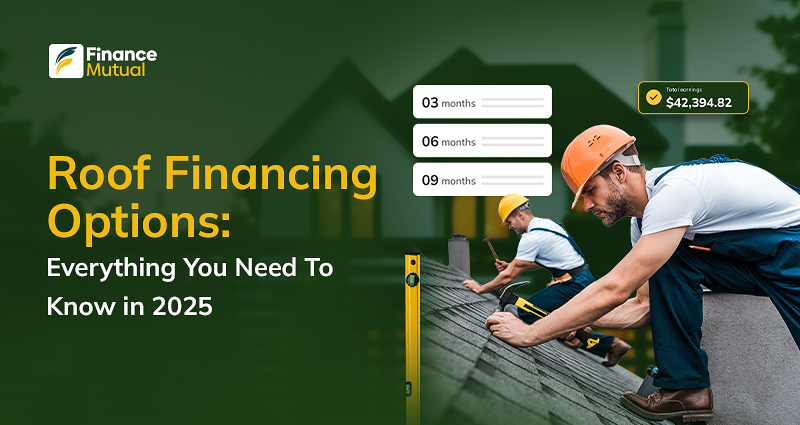
Quick Answer
What are Roof Financing Options?
Roof financing is a way to pay for a new roof or roof repairs over time instead of paying the full amount all at once. It lets homeowners spread the cost into smaller, monthly payments, making it easier to afford.
Roofing issues don’t wait for the perfect financial moment. Whether it’s a small repair or a full roof replacement, these projects are often urgent—and unfortunately, expensive. The average cost of roof repair in the U.S. typically ranges from $150 to $1,500. The severity of the damage, the type of roofing material, and the size of the repair area all influence the cost. In more complex cases, costs can go up to $3,000 or more. Most homeowners start by reaching out to a roofing contractor to assess the damage. However, many quickly find that the cost is higher than expected.
So, how to pay for a roof with no money? We’ve the answer!
Instead of postponing essential work or compromising on materials, consider roof financing options. It allows homeowners to complete their roofing project without paying the full amount upfront.
Get into the details below!
What is Roofing Financing
Roof financing is a practical solution that helps homeowners manage the cost of a new roof or major repairs through affordable monthly payments, rather than covering the entire expense upfront. After all, a roofing project is a significant investment, often ranging from several thousand to tens of thousands of dollars.
In many cases, roof repairs become necessary due to storm damage, persistent leaks, or general wear and tear over time. However, delaying or ignoring these issues often causes bigger and more expensive problems. Unfortunately, not all homeowners have enough savings on hand to cover such a large and unexpected cost.
This is where roof financing options make a difference. Many roofing contractors now offer flexible payment plans, allowing homeowners to move forward with urgent repairs or full replacements without delay. As a result, it's possible to protect the home without draining emergency funds or relying on high-interest credit cards. Overall, roof financing offers a convenient, stress-free path to maintaining a safe and secure home.
Benefits of Roof Financing Options
| For Homeowners | For Roofing Contractors |
| Easier to afford – Roofing costs can be paid in smaller monthly amounts instead of one large payment. | Competitive advantage – Offering financing can help contractors stand out in a crowded market. |
| Increased project approvals – More homeowners are likely to move forward with repairs when flexible payments are available. | Flexible payment options – Plans can be tailored to suit different budgets and timelines. |
| No delays – Urgent work can begin immediately, even without full payment upfront. | Larger project potential – Financing allows for bigger jobs or higher-quality materials to be considered. |
| Faster payments – Contractors often receive payment upfront or on a regular schedule through financing partners. | Greater sense of security – Contractors can repair or upgrade homes without financial worry. |
| Less financial pressure – Financing reduces the need for homeowners to rely on credit cards or savings. | Improved customer satisfaction – Easier access to financing leads to a better overall experience. |
Top 7 Roof Financing Options in 2025
Replacing or repairing a roof is often a major investment, but delaying it can lead to more damage and higher costs down the line. So, there are several financing solutions to check for financing a new roof or repairing it.
1. Credit Card
Many homeowners use credit cards as an easy way to pay for roof repairs, especially when a 0% interest promotional offer is available. This option benefits those handling smaller projects, provided they repay the amount within the promotional period. On the contrary, for high-cost roofing jobs, this option carries potential risks. If the balance remains unpaid after the promo period, interest rates, often above 20%, can apply, dramatically raising the total repayment amount.
💡Best for: Smaller projects with quick repayment potential.
⚠️ Caution: High post-promo interest rates and potential for long-term debt.
2. Personal Loan
A personal loan is one of the unsecured roof financing options that covers a wide range of expenses, including roof repairs or replacement. Lenders typically offer loan amounts from $1,000 to $50,000, with repayment terms between 2 and 7 years. They usually approve borrowers based on credit score and income, and often disburse funds quickly, making personal loans a suitable option for urgent roofing needs. This type of loan is chiefly helpful for homeowners without home equity. In some cases, homeowners may also use their property as collateral to secure better loan terms. Given that interest rates vary depending on creditworthiness.
💡Best for: Quick funding with predictable monthly payments.
⚠️ Caution: Higher rates for poor credit and potential origination fees.

Turn Big HVAC Bills into Small Monthly Payments
Learn how flexible financing can make your next HVAC project stress-free and budget-friendly.
3. Home Equity Loan
A home equity loan is a secured loan that allows homeowners to borrow a lump sum amount. They usually use the equity in their property as collateral, which reduces the lender’s risk. As a result, these loans typically come with lower interest rates compared to unsecured options. Borrowers repay the loan through fixed monthly installments over a term ranging from 5 to 30 years. This type of financing suits large-scale roofing projects well due to its higher borrowing limits and long-term repayment flexibility. However, using the home as collateral means that failure to repay the loan could lead to foreclosure.
💡Best for: Homeowners with strong equity and large project costs.
⚠️ Caution: Closing costs and risk to your property if not repaid.
4. HELOC (Home Equity Line of Credit)
A HELOC, or Home Equity Line of Credit, allows homeowners to borrow against their home’s equity. They can use funds as needed, similar to how a credit card works. They may find this well-suited for roofing projects that they complete in phases or that involve uncertain costs. Interest applies only to the amount drawn, and many lenders offer interest-only payments during the initial draw period, which usually spans 5 to 10 years. While the flexibility is a major benefit, HELOCs typically have variable interest rates. Hence, monthly payments could rise. Responsible budgeting is essential to prevent overuse.
💡Best for: Flexible borrowing with evolving project costs.
⚠️ Caution: Variable rates and potential risk to your home if payments lapse.
5. Cash-Out Refinance
In the list of roof financing options in 2025, another name is Cash-Out Refinance. In this option, homeowners refinance their existing mortgage for a higher amount than they currently owe and take the difference as cash. They can use the extra funds for roofing or other home improvements. Since mortgage rates usually stay lower than personal loan rates, this method often proves cost-effective. However, refinancing extends or resets the mortgage term, which adds closing costs and changes the loan structure. This approach suits long-term homeowners who plan to stay in their property and want to benefit from lower interest rates.
💡Best for: Homeowners with substantial equity seeking to refinance.
⚠️ Caution: Involves closing costs, a new mortgage term, and a longer repayment timeline.
6. Renovation Loans
Renovation loans are tailored for home improvements and can be rolled into your mortgage (like FHA 203(k) or Fannie Mae HomeStyle loans). These loans combine home purchase and renovation costs into one. Moreover, they’re useful if you’re buying a home that needs a new roof or planning major upgrades. Regardless of the downsides, like paperwork, longer approvals, and inspections.
💡Best for: Combining roof work with other home improvements.
⚠️ Caution: Stricter eligibility and a more complex application process.
7. Roofing Payment Plans
Roof financing options that are widely used by people nowadays in flexible payment plans. More and more roofing companies now partner with platforms like FinanceMutual to make roof repairs affordable for homeowners. Instead of facing complicated loan applications, homeowners can access flexible financing plans designed to fit their financial situation. What sets FinanceMutual apart is its AI-powered recommendations, which ensure customers stay on track with their monthly payments, helping both homeowners and contractors stay stress-free.
💡Best for: Customers who want flexible and simple payment options
⚠️ Caution: Eligibility may vary based on credit score.
The Final Words
Roof repairs are essential for protecting a home, yet the expense can be overwhelming. As a result, many people delay or cancel needed work simply because they can't afford the full cost. With FinanceMutual, that no longer has to be the case. Its roof financing options allow homeowners to take action immediately while paying in smaller, more manageable payments.

FAQs
1. Are There Any Roofing Companies With Payment Plans Near Me?
Yes, find FinanceMutual for getting flexible payment plans for roof repairs.
2. How Can I Pay for a New Roof With No Money?
If you don’t have money upfront, you can still pay for a new roof through financing options like payment plans, personal loans, or home equity loans.
3. Can You Finance a New Roof Installation?
Yes, you can finance a new roof installation through various options like personal loans, home equity loans, HELOCs, or contractor-offered payment plans. These solutions allow homeowners to spread the cost over time instead of paying the full amount upfront.
4. How To Get Commercial Roof Financing?
To get commercial roof financing, businesses can apply through lenders that specialize in commercial property improvements or work with roofing contractors who offer in-house financing options. Approval typically depends on business credit, revenue, and project size, with flexible terms available for repayment.

